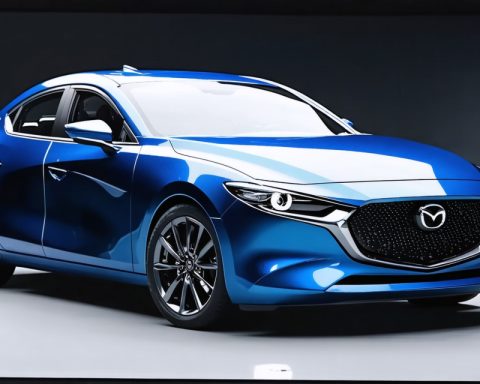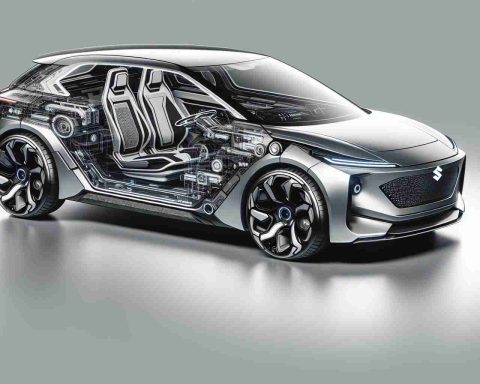- BYD aims to double international sales to over 800,000 units by 2025, expanding its market presence beyond China.
- The company navigates tariffs by sourcing components from China and assembling vehicles locally, maintaining cost competitiveness.
- BYD is focusing on markets such as Britain, Latin America, and Southeast Asia, with significant investments in Brazil, Thailand, Hungary, and Turkey.
- Despite its expansion, BYD avoids the U.S. and Canadian markets due to high tariffs and geopolitical tensions.
- The company targets robust profit margins, aspiring to surpass Toyota’s profit per vehicle, with 5.5 million vehicle sales by 2025.
- Investment in software and semiconductors reflects BYD’s commitment to enhancing smart driving capabilities for global markets by 2026-2027.
- BYD’s strategy is a blend of resilience, innovation, and strategic planning, driving its ambitious global trajectory.
A profound transformation is sweeping through the corridors of automotive might, and at its helm is the ambitious Chinese automaker, BYD. With its eyes trained sharply on global dominance, BYD plans to double its international sales to over 800,000 units by 2025—a daring leap from its 417,204 vehicles sold outside China last year. This move signals a broader strategy to carve a substantial footprint in markets like Britain, Latin America, and Southeast Asia, as shared by Chairman Wang Chuanfu in a recent earnings call.
To push past the boundaries erected by escalating tariffs on Chinese-made vehicles, BYD is crafting a resourceful roadmap. By sourcing key components from the homeland and assembling the vehicles within local markets, the automaker maintains a competitive cost edge. Yet, a veil of mystery lingers over which countries will host these assembly lines, a detail the company has yet to illuminate.
With an unyielding drive to broaden its influence, BYD’s vibrant presence can already be felt with gleaming new showrooms adorning the landscapes of Australia, Germany, and several other pivotal markets. Beyond mere retail, BYD is sowing deep roots with substantial production investments in countries like Brazil—its largest market outside China—alongside emerging hubs in Thailand, Hungary, and Turkey. However, Brazil’s journey wasn’t entirely smooth. The path was marred by hurdles stemming from labor disputes last year, casting shadows on its otherwise bright future plans.
Intriguingly, despite its vast ambitions, BYD is currently refraining from venturing into the U.S. and Canadian arenas, attributing this caution to prevailing geopolitical tensions. These markets remain stringent, bolstered by a stiff 100% tariff on Chinese-made EVs—a policy firmly entrenched by the Trump era and upheld in Canada.
While the geopolitical landscape dictates current limitations, BYD’s focus remains unrelenting: to bolster profit margins. Chairman Wang exudes confidence that BYD’s profit per vehicle could eclipse that of industry titan Toyota, which behemothly sold 10.8 million vehicles in 2024. BYD’s clear target stands at 5.5 million vehicles by 2025, energized by aggressively competitive pricing and feature-laden offerings like its Seagull EV—a model capturing hearts with its sub-$10,000 price tag.
Further empowering its vision, BYD is pouring investments into its software and semiconductor teams, with plans to expand this technical brigade from 5,000 to 8,000 specialists. This fortification aims at sharpening its smart driving capabilities, a beacon set to illuminate global markets by 2026 or 2027 with robust deployment teams stationed internationally.
BYD’s narrative is not merely about manufacturing electric vehicles; it is an epic of resilience, innovation, and strategic foresight. As the global landscapes evolve, BYD is not just adapting; it is architecting its future, driving forth with electrifying determination.
The Dynamic Rise of BYD: Steering the Future of Global Automotive Markets
The Ambitious Journey of BYD
The profound transformation within the global automotive industry is being led by none other than the ambitious Chinese automaker, BYD. With its bold vision to double international sales to over 800,000 units by 2025, BYD is aggressively expanding its footprint across continents, positioning itself as a significant player in emerging and established markets.
Expanding Global Markets
Key Strategic Regions
1. Southeast Asia and Latin America: BYD is eyeing markets like Britain, Latin America, and Southeast Asia, aiming to establish a stronghold outside China. Brazil, in particular, serves as an important market, though it has experienced some challenges due to labor disputes.
2. Europe: With new showrooms in places like Germany and investment hubs like Hungary, BYD is setting the stage for significant growth in European markets.
Overcoming U.S. and Canadian Barriers
Due to persistent geopolitical tensions and tariffs, BYD is withholding from entering the U.S. and Canadian markets, focusing instead on nurturing other locales where trade barriers are more favorable.
Competitive Edge Through Local Assembly
To tackle high import tariffs and maintain cost efficiency, BYD is planning local assembly lines in key markets while sourcing vital components from China. This strategic workaround will enable competitive pricing and circumvent stringent tariff challenges. However, the exact locations for these facilities remain undisclosed but are pivotal to BYD’s international strategy.
Investment in Technology and Innovation
Driving Technological Advancements
BYD is making substantial investments to beef up its technology backbone, growing its software and semiconductor teams from 5,000 to 8,000 experts. This leap will bolster their smart driving technologies, setting the stage for international deployment by 2026-2027.
Product Innovations: The BYD Seagull and Beyond
Affordable and Feature-rich Models
BYD is not only focusing on expanding its market presence but also revolutionizing its product offerings. The BYD Seagull, for instance, has attracted considerable attention due to its sub-$10,000 price tag, challenging competitors with affordability and advanced features.
Market Forecast and Industry Trends
Aiming for the Top
BYD’s focus is laser-sharp on increasing profitability and boosting sales. With a target of selling 5.5 million vehicles by 2025, BYD is on a path that could see its profit margins rivaling industry giants like Toyota.
Pressing Questions Answered
– Why is BYD not entering the U.S. market? – Tariffs and geopolitical tensions are primary deterrents, but BYD might reconsider if the landscape changes.
– What are BYD’s plans for software advancements? – Expanding expert teams and deploying advanced smart driving capabilities globally.
– How does BYD plan to sustain competitive pricing? – By assembling vehicles locally to mitigate tariffs and reduce costs significantly.
Actionable Insights for Consumers
– Consider BYD for Affordable EVs: With models like the BYD Seagull, consumers looking for affordable yet feature-rich electric vehicles can find great value.
– Watch Emerging Markets: Keep an eye on markets like Southeast Asia and Europe for the latest developments and product releases from BYD.
Conclusion: Steering Towards a Sustainable Future
In summary, BYD’s ambitious plans and strategic maneuvers illustrate a robust blueprint for not just surviving but thriving in the ever-evolving global automotive saga. As BYD scales its technological innovations and market reach, it epitomizes resilience and forward-thinking strategy, setting a high standard for the automotive industry.
For more insights into automotive innovations, visit the official BYD website.













